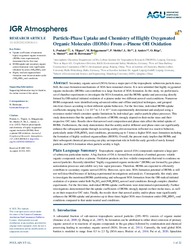Particle‐Phase Uptake and Chemistry of Highly Oxygenated Organic Molecules (HOMs) From α‐Pinene OH Oxidation
Brüggemann, M.
Mettke, P.
He, L.
Anders, J.
Böge, O.
Mutzel, A.
DOI: https://doi.org/10.1029/2021JD036414
Persistent URL: http://resolver.sub.uni-goettingen.de/purl?gldocs-11858/10466
Persistent URL: http://resolver.sub.uni-goettingen.de/purl?gldocs-11858/10466
Poulain, L.; Tilgner, A.; Brüggemann, M.; Mettke, P.; He, L.; Anders, J.; Böge, O.; Mutzel, A.; Herrmann, H., 2022: Particle‐Phase Uptake and Chemistry of Highly Oxygenated Organic Molecules (HOMs) From α‐Pinene OH Oxidation. In: Journal of Geophysical Research: Atmospheres, Band 127, 16, DOI: 10.1029/2021JD036414.
 |
Dokument öffnen: |
Secondary organic aerosol (SOA) forms a major part of the tropospheric submicron particle mass. Still, the exact formation mechanisms of SOA have remained elusive. It is now admitted that highly oxygenated organic molecules (HOMs) can contribute to a large fraction of SOA formation. In this study, we performed a set of chamber experiments to investigate the SOA formation, and the HOMs uptake and processing directly formed by OH‐radical initiated oxidation of α‐pinene under two different aerosol seed conditions. Numerous HOM compounds were identified using advanced online and offline analytical techniques, and grouped into four classes according to their different uptake behaviors. For the first time, individual HOMs uptake coefficients ranging from 1.1 × 10−2 to 1.5 × 10−1 were experimentally determined and analyzed using a resistance model which considers uptake limitations by individual gas‐ and/or particle‐phase processes. This study demonstrates that the uptake coefficients of HOMs strongly depend on their molar mass and their respective O/C ratio. Results show that aerosol seed composition and phase state affect the initial uptake of HOMs. Furthermore, the study demonstrates that the acidity and/or different seed phase‐state can significantly enhance the subsequent uptake through occurring acidity‐driven reactions reflected in a reactive behavior, particularly under (NH4)HSO4 seed conditions, promoting up to 3 times a higher SOA mass formation including the formation of highly oxidized organosulfates (HOOS). Overall, the present study implies that HOMs and their subsequent chemical processing can play an important role in both the early growth of newly formed particles and SOA formation when particle acidity is high. Plain Language Summary:
Tropospheric organic aerosol (OA) compounds represent a large part of submicron particulate matter. A big fraction of OA is formed from oxidation of emitted gaseous volatile organic compounds such as α‐pinene. Oxidation products are less‐volatile compounds that tend to condense on aerosol particles. Recently identified “highly oxygenated organic molecules” (HOMs) are formed by gas‐phase autoxidation processes and exhibit very low vapor pressures. Therefore, HOMs are expected to efficiently contribute to secondary organic aerosol (SOA). However, up to now, SOA formation potential of HOMs is still not well described because of lacking experimental investigations and analysis. Consequently, this study aims to investigate the mentioned HOMs partitioning and subsequent SOA formation from the OH‐radical initiated oxidation of α‐pinene under both Na2SO4 and (NH4)HSO4 aerosol seed conditions through complex chamber experiments. For the first time, individual HOMs uptake coefficients were determined experimentally. Further investigations demonstrated that the uptake coefficients of HOMs strongly depend on their molar mass, as well as on their respective O/C ratio. Finally, the results show that aerosol acidity and/or phase state significantly enhances the HOMs uptake and promotes up to three times higher SOA mass formation under (NH4)HSO4 seed conditions compared to that under neutral seed conditions. Key Points:
Uptake coefficients of numerous highly oxygenated organic molecules (HOMs) were experimentally determined for the first time.
HOMs uptake and secondary organic aerosol formation were significantly enhanced by acidic (NH4)HSO4 seed.
Highly oxidized organosulfates formation were observed under acidic (NH4)HSO4 seed conditions.
Statistik:
ZugriffsstatistikSammlung:
This is an open access article under the terms of the Creative Commons Attribution‐NonCommercial‐NoDerivs License, which permits use and distribution in any medium, provided the original work is properly cited, the use is non‐commercial and no modifications or adaptations are made.

